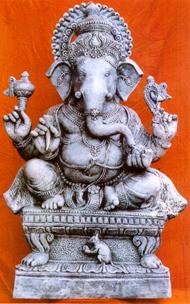GANESHA
AND THE HINDU PANTHEON |
|
In China Ganesha is accepted in his spiritual aspect as Vajradhathu and in his material aspect as garbhadathu. In Japan he is called Vajara Vinayaka in double form, one male and the other female known as Kangi and Ten. Japanese consider these figures as of great esoteric significance and worship them in secret. The worship of Ganesha in China and Japan appears to be due to the influence of Thantric Buddhism. The Mongolians also adored Ganesha through the influence of the Chinese. There is a story in extant that Emperor Kublai Khan's father was childless and he was advised to pray to Ganesha to bless him with a son. The prayer bore fruit and the childless father was blessed with a son who became the illustrious Kublai Khan. The influence of Ganesha did not last long in Mongolia. Ganesha figures also have been unearthed in Mexico. There must have been some communication between India and Mexico as otherwise it will be difficult to explain how the idols of Ganesha reached Mexico. In 1868 Father Zumloohm discovered in Easter Island in Pacific Ocean a number of wooden Tablets called Kohan Mongo (news boards) which were covered with script signs. The Hungarian Scholas Hevesy recognised a startling resemblance between their Easter Island script and Indus Valley script and he thinks that the script followed migrations from South East Asia. Such being the case there in nothing improbable if we say that Ganesha also followed migrations from South East Asia and reached Mexico. It is for the research scholars to find out how Ganesha reached Mexico and how he fared there. |
